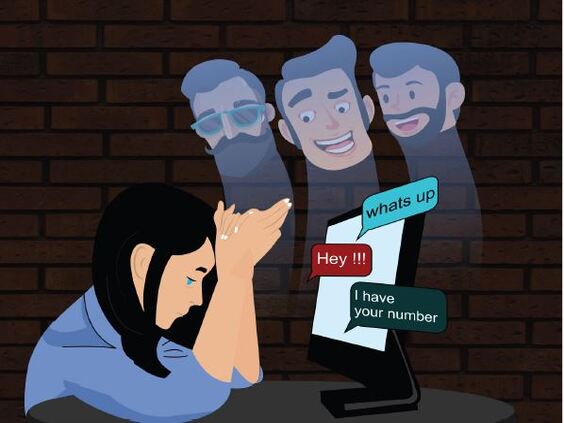

Imagine a woman sitting on a bus, quietly scrolling through her phone, when suddenly, an obscene photo pops up via AirDrop or WhatsApp. She didn’t ask for it, doesn’t know the sender—and yet, her sense of security is shattered in seconds. This is cyber flashing.
What is Cyber Flashing?
Cyber flashing is the act of sending sexually explicit images or videos to unsuspecting individuals, often via Bluetooth, AirDrop, or instant messaging apps like WhatsApp, Telegram, or Signal. What was once a prank for some has now become a serious form of cyber sexual harassment, and India is no exception to this disturbing trend.
Why Should Law Enforcement Take This Seriously?
As custodians of law and order, it's vital for the police to understand that cyber flashing is not just a digital prank—it is a gateway to psychological trauma and fear, and sometimes, escalates to stalking or physical threats.
The Numbers Speak:
- According to NCRB data (2022), over 21,000 cybercrime cases related to women were reported—many involving obscene content or unsolicited messages.
- A study by Amnesty International revealed that 1 in 5 women in India have received unwanted sexual content online.
- In metropolitan cities, 62% of young women report receiving sexually explicit images from strangers.
Yet many victims don’t report due to embarrassment or lack of awareness about legal support.
Red Flags: Identifying Victims and Situations
Officers need to be trained to identify when a victim might be experiencing cyber flashing. Here are key warning signs:
- They receive unsolicited explicit content from unknown senders.
- They're visibly distressed, anxious, or shaken after a phone notification.
- They exhibit signs of withdrawal or fear, especially in public or digital spaces.
- Complaints mention phrases like: "random images sent via AirDrop", "unknown caller sent obscene video", or "harassed online by strangers."
Tech Tactics: How It Happens
Cyber flashing is often done using proximity-based sharing tools like:
- AirDrop (Apple devices): If set to “Everyone,” anyone nearby can send unsolicited images.
- Bluetooth sharing: Hackers can exploit open connections.
- WhatsApp Video Call Exploits: Perpetrators call and expose themselves before the receiver hangs up.
- Telegram/Signal messages: Encrypted, disappearing messages make it hard to trace.
Cyber Flashing is a Crime: Know the Laws
While India does not yet have a law titled cyber flashing, several provisions under the Indian Penal Code (IPC) and the Information Technology (IT) Act, 2000 cover it:
- Section 354A IPC: Sexual harassment.
- Section 66E IT Act: Violation of privacy.
- Section 67 IT Act: Publishing or transmitting obscene material.
- Section 507 IPC: Criminal intimidation by anonymous communication.
Offenders can face up to 3 years in jail, fines, and a permanent mark on their digital profile.
What Can Police Officers Do?
Your role is critical in preventing, investigating, and stopping cyber flashing. Here’s how you can help:
Proactive Policing:
- Awareness Campaigns in Schools & Colleges
Organize sessions that educate students about privacy settings, digital etiquette, and how to report incidents.
- Sensitize Your Force
Include cyber flashing in police training. Officers need to understand digital behavior, especially crimes against women.
- Quick Response Units for Cyber Incidents
Create city-wise cyber cells that can act fast—every hour counts in digital cases.
How Victims Can Protect Themselves (and What Police Should Recommend)
As a frontline protector, guide citizens—especially women and teens—on simple ways to prevent such attacks:
Digital Safety Tips:
- Disable AirDrop (on iPhones): Keep it set to “Contacts Only” or “Receiving Off.”
- Turn off Bluetooth/WiFi in crowded places when not in use.
- Use Privacy Settings: Lock profiles, limit story views, and restrict messages from strangers.
- Ignore Unsolicited Video Calls: Never pick unknown calls—especially on WhatsApp or Telegram.
- Take Screenshots: If someone does flash or harass digitally, document it immediately.
Evidence Collection:
As an officer, always advise victims to preserve digital evidence, including:
- Screenshots
- Video recordings
- Phone logs
- Device metadata (if available)
This helps immensely during FIR registration and legal proceedings.
How to File a Cyber Flashing Complaint
“Don’t suffer in silence. You have rights. You have support.”
Guide victims to report incidents without hesitation:
- Visit Your Nearest Cyber Crime Cell or police station.
- File a Complaint Online: www.cybercrime.gov.in
- Provide:
- Screenshots or files
- Chat history or call logs
- Time/date of incident
- Device information (if known)
Ensure a safe space for the victim while recording the statement.
Global Context: What the World Is Doing
- UK criminalized cyber flashing in 2023 under its Online Safety Bill. Offenders can face up to 2 years imprisonment.
- Texas, USA, was the first state to ban cyber flashing in 2019.
- In South Korea, sending unsolicited explicit photos is treated as sexual violence.
India must follow suit with stronger, victim-friendly laws.
Suggested Action for Police Departments
“Include cyber flashing in your regular crime briefs. It’s not just a cyber issue—it’s a psychological assault.”
Final Thoughts: This Is a Fight We Can Win
Cyber flashing is not just a digital prank—it is abuse, and it violates a person's right to dignity and safety. As police personnel, your digital awareness is as important as your physical presence in communities. Whether it's a street patrol or online surveillance, your vigilance can save lives, prevent trauma, and uphold justice in both the physical and virtual worlds.
The smartphone has become the new battleground for crimes. The more we understand it, the better we protect our people.
Cyber Hygiene Foundation
- CyberAwareness CyberSafety PersonalDataProtection SafeInternetForAll CyberHygieneForAll DigitalSecurityLaw NetworkDefense ITSecuritySolutions
You May Also Like It
Understanding the Growing Threat of Loan Frauds Loan frauds have become
In your role as protectors of law and order, you
Leave A Comment
Don’t worry ! your e-mail address will not published.








0 Comments